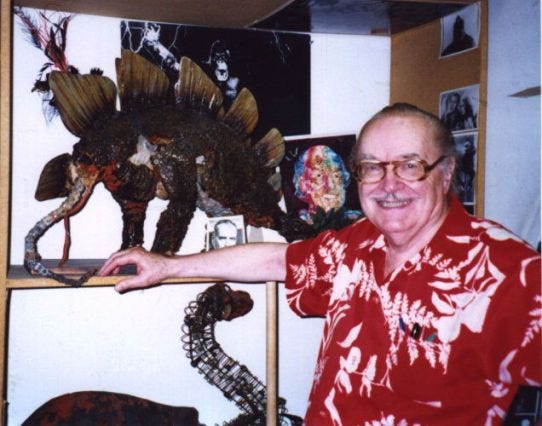I want to borrow a story from someone I cared about a great deal. He’s no longer with us, so hopefully, I won’t offend his spirit.
Before the whole world started talking about science fiction, only a small fraternity cared about science fiction. It was mostly boys, and mostly boys who weren’t very good at sports and didn’t have as many friends as other boys. It was the birth of a cliche.
Within this awkward fellowship of boys arose an informal leader, a bespectacled stranger named Forrest J Ackerman with a pencil-thin mustache and a love for funny-sounding words. There’s a secret sect in an entire generation of boys who can identify each other simply by using the sobriquet “Uncle Forry.”
Ackerman was an expert on every science fiction writer, starting with Shelly, who invented the genre by writing a ghost story to try to make a point to her husband and his boyfriend. Ackerman didn’t write much fiction himself, but he was considered an excellent editor and literary agent, most infamously for L. Ron Hubbard. Just mentioning Hubbard’s name could cause Uncle Forry to roll his eyes. Clearly, there were stories to be told there, but he never told them when I was around to hear them.
Not many science fiction movies were made for a long time because they were considered complicated, expensive, and risky for a market that mostly consisted of lonely boys. The post-war baby boom changed all that. Advances in film technology and the encroaching tidal wave of teenage boys sweeping the country introduced a new era of science fiction movies, made possible by the drive-in theater, and Forrest Ackerman would become its king by producing a pulpy magazine featuring openly exploitative covers with garish colors called Famous Monsters of Filmland Magazine.
Like many boys his age, Ackerman volunteered for military service after Pearl Harbor. A Staff Seargent, he edited the camp newspaper at Fort Mcarthur. After the war, he shared in the national exuberance that most of the country had. America could do anything, or so we thought. We could go to the moon if we wanted, and so we did.
With this avalanche of optimism came a new aesthetic. We call it mid-century modernism now, but at the time, it was just “modern!” Ackerman embraced this modernism with abandon. A Hawaiian shirt without any suggestion of a tie or hat became his favorite mode of attire. He covered his entire home with avocado-green shag carpet and then covered that with the greatest science fiction collection ever assembled.
One day, he was driving home when he heard a man on the radio discussing the advances in electronic audiophonic devices that could play music with unheard-of levels of high fidelity, which he called “hi-fi.” A fan of mod phrases, Ackerman began turning the word over in his head, and slowly, it merged with the other love of his life (who wasn’t named Wendayne). By the time he got home, he had invented the phrase “Sci-Fi” to mean Science Fiction.
Having many friends in the genre and, at the time, publishing no less than six magazines on the subject, Ackerman spread his new word around the world. Everyone soon heard of Sci-Fi! Since the new word came from Uncle Forry, most people were excited to receive it—most, but not all.
If you asked him, Harlan Ellison would tell you he made a great deal of money writing science fiction for television. He would probably tell you anyway, even if you didn’t ask him. Ellison was very proud of the fact that he didn’t write for children like many of his peers did. He wrote serious science fiction. He wrote it very well; if you don’t believe him, ask him.
Harlan Ellison hated the phrase “sci-fi.” He thought it made the entire genre of science fiction sound juvenile. In his mind, Ackerman’s legion of pimple-faced teenage fans were ruining science fiction. “What the hell is ‘sci-fi?’” He said. “It sounds like crickets fornicating!” Only, he didn’t say fornicating.
The crowd that circulated around Ackerman had experienced Ellison’s grumpy barbs before. His dissatisfaction with “sci-fi” amused them to no end. One went so far as to print bumper stickers that read, “Ask me about copulating crickets!” Which the others proudly wore on their cars to express their solidarity in the great war between Ackerman and Ellison. It even became a lapel button!
At this point, I should point out that I don’t know how much of the story is real and how much of the story is two science fiction legends playing up the tale of an imagined rivalry to appease their mutual fans. Ackerman was gentle and kind and very much the “Uncle Forry” you heard so much about. Ellison was famously a grumpy curmudgeon, but he genuinely loved his genre, fans, and peers; he just had a funny way of showing it. For the sake of the story, though, let’s assume it was just as they both told it.
I can tell you that “Sci-Fi” as a word stuck. Even a few old-timers know what “copulating crickets” means, but everybody knows what “Sci-Fi” is. One of the things I love about science fiction is that it’s not just stories about science and fiction; some of my favorite sci-fi stories are about the people who made it.
Below is a photograph I took of Uncle Forry in 1992. It shows him with what remains of the King Kong animation models and wearing a vivid Hawaiian Shirt. This photograph is one of the first things I ever put on the internet, and I’ve seen it reprinted at least a thousand times now. It makes me happy every time I see it.


